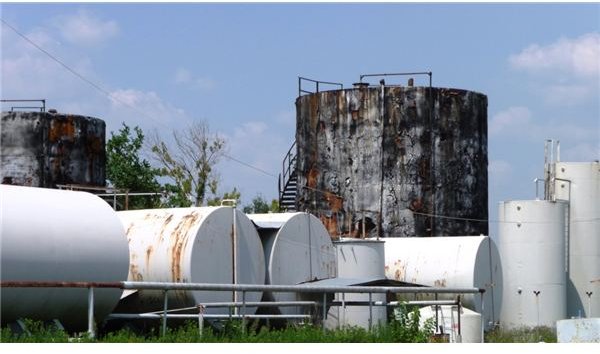Causes of Plastic Tank Failures
Types of Plastic Tanks
Today we have synthetic storage tanks for different purposes and capacities. From storing a few hundred liters of water in a household water tank to storing thousands of liters of chemicals in an industry plant, plastic storage tanks have made life easy. We can divide these tanks into the following broad categories:
-
Food and Milk Storage Plastic Tanks - These tanks are often used to store food grains in warehouses. Usually, such tanks are not of large capacity, and they protect food from moisture and fungal attack as they are air-tight containers. For the storage of milk, plastic tanks are not too popular, yet they serve the basic purpose of transporting milk from one place to another without any spillage. As plastic tanks resist atmospheric heat, the milk remains safe from external heat. Plastic tanks are also used for wine barrel racking systems.
-
Chemical Storage Tanks - Storing chemicals in a plastic tank has become very popular of late. Tanks lined with linear polyethylene are suitable for stationary storage of chemicals. The reactivity of plastic with almost every chemical substance, except a few highly reactive ones, is very slow. Multilayer plastic tanks easily resist the corrosive and abrasive actions of chemicals. Brine tanks, double wall storage tanks, and underground plastic tanks are some of the most popular plastic storage options available for chemical storage.
-
Glass Reinforced Plastic Tanks - These tanks are suitable for the storage of chemicals, liquids, solids, and everything else that does not fall in the category of highly reactive substances. Fiberglass reacts only once with the chemicals, and this is to develop immunity against further reactions. Fiberglass plastic tanks are expensive, but they are robust, strong, and durable.
Another major categorization of storage tanks is based on their mode of use. Vertical tanks are used for stationary or overhead use, whereas horizontal tanks are used for transportation purposes like carrying chemicals or goods from one place to another.
Failure of Plastic Tanks
Plastics have replaced metals as far as storage technology is concerned. Most containers that were once made of metal are now available in plastics. Metal containers were heavy and expensive, but plastic storage tanks solved these problems at once. However, plastic containers have certain drawbacks which result in their failure. Common failure modes are discussed below.
-
Plastics change their shape considerably with changes in temperature; the strength and stiffness of plastics also varies with the external temperature. Polyvinyl chloride (PVC) becomes brittle when exposed to cold temperature. In cold regions, moisture and freezing may damage the storage tanks.
-
Another common mode of failure of plastics is creep, which means failure or deformation of a solid substance under stress. When exposed to stress, plastics can deform and this can result in failure of the structure. Environmental stress cracking may cause chemicals to react with the material of the storage container, which is otherwise resistant to the chemical composition of the stored material.
-
Bad installation is another major cause of storage tank failure. It is advisable to have a smooth concrete slab so that the tank can rest over it. If the tank rests over an uneven surface, asymmetrical loading will result in base failure of the tank. Secondly, if the surface is not even, it will create problems while shifting or moving the tank from one place to another.
-
Glass Reinforced Plastic (GRP) tanks are durable, robust, and resistant to chemicals, but they come with prerequisities like operating conditions, temperatures, and the amount to be stored in a tank. Failing to follow these conditions almost always results in failure of GRP tanks.
Remedial Measures
Safeguarding storage tanks and increasing their life is not a big deal, provided certain guidelines are kept in mind. Plastic is strong and robust but it must not be taken for granted that it will perform in rain, snow, and heat equally. Here is a list of dos and don’ts which might help you to increase the life of your plastic storage tank.
-
Install tanks carefully, following the user’s manual. These always mention installation procedure, and installing according to the procedure will definitely make your tank last longer.
-
Certain tanks are reactive to some household chemicals, so make sure you keep those chemicals out of reach of your storage tank. Once again, the user’s manual will let you know about the chemical reactivity of your storage tank.
-
Performance of GRPs is highly dependent on temperature conditions. Select the GRP tank according to the temperature and environmental conditions of your area.
-
Use additives carefully to seal minor cracks. Additives are chemical solvents and in some cases they may damage your vessel rather than repairing it. Additives have a corrosive nature, so read instructions before using them.
-
If you are storing water or liquid in your tank, do not let it overflow. Overflowing liquid means continuous exposure to moisture, which might affect strength of your storage tank.
-
Avoid catastrophic storage tank failure by monitoring the condition of your overhead water tanks regularly. Replacing a tank at the right time is important in case it has become brittle, deformed, or weak.
-
If you intend to store chemicals or fertilizers in your tank, always perform specific gravity check of material of the tank. Higher specific gravity means an ability to withstand larger hydrostatic stresses.
To increase life of storage tanks and avoid tank failures, it is advisable to only use compatible accessories like gaskets, expansion joints and hoses. It becomes very important in case of horizontal tanks, that are designed to travel distances.
References
Glass Reinforced Plastic vessels and Tanks, https://www.hse.gov.uk/pubns/guidance/pm75.pdf
Ploy Tanks, Purdue University (pdf)
Five Year Inspection of Plastic Tanks, https://www.dec.ny.gov/regulations/38102.html
Image
Horizontal and Vertical Tanks, Morguefile.com, https://www.morguefile.com/archive/display/698955
